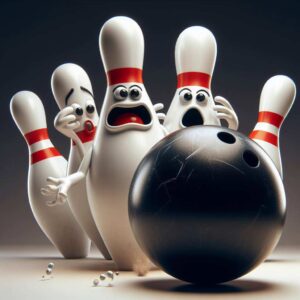Since the early origins of the 10-pin bowling sport, players have pursued the ultimate achievement – a perfect 900 series.
While still not accomplished in sanctioned competitive play, some incredibly high scores have been bowled across bowling’s history. From professionals like Walter Ray Williams Jr. to amateur league players, the boundaries of bowling high scores continue getting pushed.
So what scores stand out as the highest in bowling history? What factors allow elite players to reach scoring feats deemed nearly impossible?
In this deep dive, we’ll break down the highest bowling scores overall, including the highest score in a professional tournament, the highest score in unsanctioned amateur play, and more record-setting performances.
Highest Score in Professional Tournaments – Walter Ray Williams Jr.
When examining the highest scores achieved in professional, competitively sanctioned bowling tournaments, one name stands above the rest – Walter Ray Williams Jr. Nicknamed “Deadeye” for his incredible accuracy, Williams has built a storied Professional Bowlers Association (PBA) career since turning pro in 1979.
He holds the record for most career PBA Tour wins at 47, along with 7 PBA50 Tour wins and a streak of 17 combined titles in three years alone.
So it’s no surprise Williams also boasts the highest score ever recorded in a professional bowling tournament. During the 2006 Banquet Open, Williams set the still-standing PBA record with a score of 1,927 across 56 games.
That averages out to nearly a 270 average! He bested his previous record of 1,913 set in 1984’s Quaker State Open held for over 20 years.
Williams’ scoring feats speak both to his consistency and versatility as a professional bowler adept at adapting his game across different lane conditions.
When oil patterns make striking more difficult, he possesses a world-class spare shooting ability to still post big scores. The fact the PBA’s highest tournament score has stood for 18+ years shows how incredible Williams’ 1927 performance was.
Highest Bowling Score, USBC League Play – Bill Bunetta
While Williams owns the record for the highest score across PBA competition, the United States Bowling Congress (USBC) maintains records for sanctioned league and tournament play for amateur bowlers.
Within those recorded statistics sits the highest certified USBC individual league score, rolled in 1981 by then 55-year-old Bill Bunetta.
Across three straight games in the Tuesday Night Classic league at Diamond Lanes in Michigan, Bunetta tallied scores of 300, 299, and 279 for an astounding 878 series. That beat the previously certified USBC highest league score of 863 set by Jack Biondollilo in 1946 by a shocking 15 pins.
Bunetta himself described his 878 performance as a “magical night,” catching the right breaks on crucial shots including solid pocket 7-10 splits picked up twice. 81 years old at the time of this writing in 2024, Bunetta’s record score has stood for over 40 years since that magical 1981 night.
Highest Bowling Score, Unsanctioned Play – Glenn Allison
While Williams and Bunetta own the highest countable scores in sanctioned PBA and USBC play respectively, even higher totals have been bowled across non-sanctioned games.
On July 1, 1982, amateur bowler Glenn Allison etched his name in bowling lore with the undisputed highest score ever recorded – a perfect 900 series across 3 straight 300 games.
Bowled at Lafayette Lanes in Lafayette, California, Allison’s 900 performance came during an unsanctioned league lacking official score verification processes.
However, hundreds of witnesses and extensive subsequent analysis verified Allison’s flawless set. He averaged 220 RPM with 17 MPH speed using the popular Columbia Yellow Dot bowling ball.
Allison’s games that fated day read:
Game 1: 300 Game 2: 300 Game 3: 300
Series Total: 900
Allison’s story shows that even non-professional league environments can produce epic scores when everything aligns for a talented bowler. Let’s examine other leading high scores in bowling history outside of sanctioned environments.
Other Notable High Bowling Scores
While Williams, Bunetta, and Allison own the 3 quantifiable highest bowling scores on record, other impressive performances deserve mention:
- John Buchanan – 886 series (300-278-300-8) in club league play in 2021. Verified by USBC but not eligible for record certification due to 4-game format.
- Bob Strampe – 876 series (267-300-300-9) in Money League play in 2020. Also verified but not record-eligible.
- Mike Klimek – 863 series (267-267-267-62) in 1992 – Highest 4-game series on record.
- Robert Mushtare – 848 series (266-266-266-50) in 1992 – 2nd highest 4-game record behind Klimek.
- Jeanette Baker – 847 series (263-278-279-27) in 2000 – Highest women’s 4-game series.
The scores above showcase elite talent even amongst amateur league bowlers taking their game to a high level. Top recreational players today sport averages unthinkable to casual 160-170 average league bowlers a generation ago.
When Lane Conditions and Skill Align – Chasing 900
In examining the highest bowling scores ever recorded, natural questions about the factors enabling such totals arise. Under what scenarios can even pro players realistically pursue that elusive 900 series?
Lane Conditions
The oil patterns applied to bowling lanes before play begins significantly impact scoring possibilities. For right-handed bowlers, oil on the outside part of the lane allows the ball to grip and hook powerfully into the pocket at the ideal angle. Without enough oil, balls hook early and erratically, making strikes less likely.
To enable higher scores, bowlers want lane oil technicians to apply an “easy” pattern with more oil towards the edge boards. This allows them to play a consistent line on every shot maximizing power and accuracy.
During Allison’s 900 games, mechanics oiled what players described as an extremely easy, bowler-friendly pattern with gobs of oil on the edge. Even solid pocket shots might leave some nasty splits and tricky spares on tougher patterns, so bowlers chasing records benefit from more forgiving setups.
Bowling Skill and Technique Mastery
Of course, even with easy oil, achieving scores near 900 requires immense skill. Bowlers need both supreme physical game capabilities and mental fortitude to sustain flawless play across long tournaments and league sets.
On the physical side, milestones like a 900 series demand masterful timing, high revolutions, matched speed/power, and the ability to play different arrow lines. Throw in top-grade spare shooting and bowlers like Williams demonstrate the comprehensive excellence that chasing huge scores necessitates.
Mentally, chasing records tests nerves and concentration severely. Bowlers have described the pressure escalating with every successive strike as dreams of perfection emerge. Allison himself nearly switched balls mid-set but opted to trust his skills and equipment. Greats like Williams possess legendary focus blocking out surroundings in route to top performances.
Bowling Ball Technology
Surprisingly, drastic evolutions in ball technology have sparked debate around record legitimacy instead of unambiguous scoring growth. Iconic past milestones used equipment specs like urethane covers and pancake weight blocks that modern associations outlaw.
However, others argue contemporary reactive resin balls prove more challenging for record chases since higher hook shapes need greater finesse to control. Pros frequently change surface roughnesses to match transitioning lane conditions during long tournaments too.
Overall, experts suggest understanding old and new equipment helps appreciate both historical feats and the different skills current players demonstrate. Comparing scores directly across eras simply proves complicated. Ultimately, bowlers still need exemplary technique and execution foundation over any equipment advantage.
The Perfect Game – 900 Series Recognition
Given no bowler has achieved a 900 series within a certified, sanctioned setting, both the USBC and PBA officially recognize the score as the pinnacle possible.
While reached countless times across informal play, both associations await the first competitors to officially join Allison in the record books.
Other sports also maintain records for still theoretical accomplishments. For example, baseball lists a perfect game as only 27 batters retired in order despite 20+ unofficially reported 28-up-28-down games in history.
Baseball historians expect pitch counts and specialist use to eventually produce 20-strikeout perfect games as well.
Similarly in bowling, evolving technology and training may eventually crown sanctioned 900s. With scores trending upward yearly across both professional and league environments, current players keep inching closer toward inevitable perfection.
Conclusion – Pushing Bowling’s Scoring Limits
From Williams’ PBA record book supremacy to Bunetta’s USBC milestone to Allison’s flawless exploits, the highest bowling scores in history showcase elite talents combining both physical capabilities and mental tenacity.
As lane conditioning knowledge grows, new balls are released constantly, and training methodology improves, even loftier totals appear on the horizon.
Maybe you’ll be part of the next generation of bowlers to take perfect shots or challenge Williams’ long-held tournament records. With training and some fortunate breaks, remarkable feats once deemed unthinkable may lie just around the corner at your local league or tournament.
Frequently Asked Questions
Why is 292 the rarest score?
A 292 game is the rarest score in bowling because it requires getting 11 strikes and 1 open frame across a single game. It’s extremely difficult to roll 11 consecutive strikes but fail to finish out the set with 3 more for a perfect 300 game. Far more 300s are bowled than 292s.
Can you score 300 in bowling?
Yes, you can score a perfect 300 game in bowling. This requires getting strikes in all 10 frames and rolling 12 total strikes for the maximum score. Over 6 million certified 300 games have been bowled to date.
Can you go over 300 in bowling?
No, you cannot score higher than 300 in a single bowling game. A 300 represents the perfection of 12 strikes across the full 10 frames. Some tournaments use formats going over 3 games where total scores can exceed 300, but 300 remains the max in an individual game.
Can you get a 600 in bowling?
Yes, you can score a 600 series in bowling, which equates to bowling games of 200 or higher back-to-back-to-back. While challenging for amateur league bowlers, professionals, and other elite players regularly score 600+ for their 3-game series totals in tournaments.
Is it possible to score a 299 in bowling?
Scoring a 299 in bowling, which equates to getting 11 strikes but failing to convert the 12th, is possible but does not happen frequently. It showcases the difficulty for even highly skilled bowlers to put together the 12 strikes required for perfection. Any minor form breakdown ends hope of 300.
Has anyone ever bowled a 292?
With only 11 strikes required, some bowlers have recorded certified 292 games in bowling history. But the score remains exceptionally rare compared to 300s or other high scores ending in strikes. It demands nearly flawless play just shy of perfection on the final shot.
Has anyone bowled a 900?
Yes, amateur bowler Glenn Allison bowled a certified 900 series across 3 straight games in 1982 for the highest scores recorded in bowling history. No one has successfully bowled 900 within a professionally sanctioned tournament yet, though. That remains the final frontier for elite pros.
What is 3 strikes in a row called?
In bowling lingo, throwing 3 consecutive strikes is referred to as a “turkey.” Longer strike streaks also get nicknames, like “golden turkey” for 4 straight or “flock of turkeys” for 5+ in a row.
Can you bowl a 300 without all strikes?
No, scoring a perfect 300-game requires getting strikes in all 10 frames. With 12 total shots in a game, all shots must knock down all 10 pins to total 300 points. Anything less than 12 consecutive strikes equates to a score below 300.





